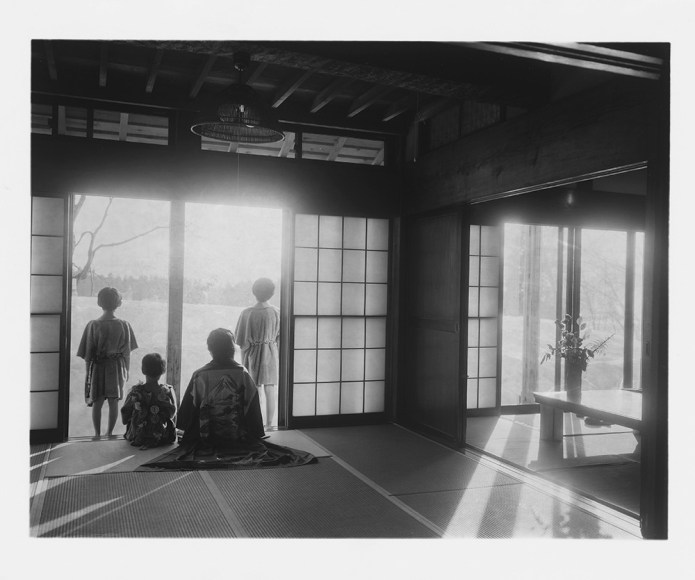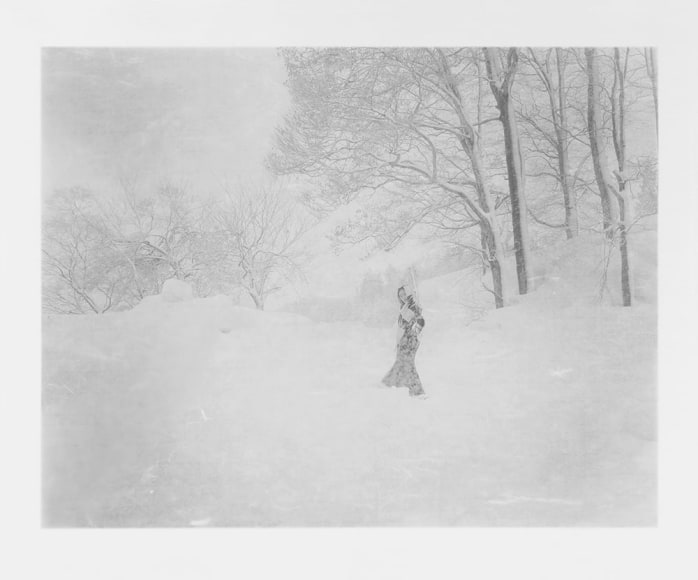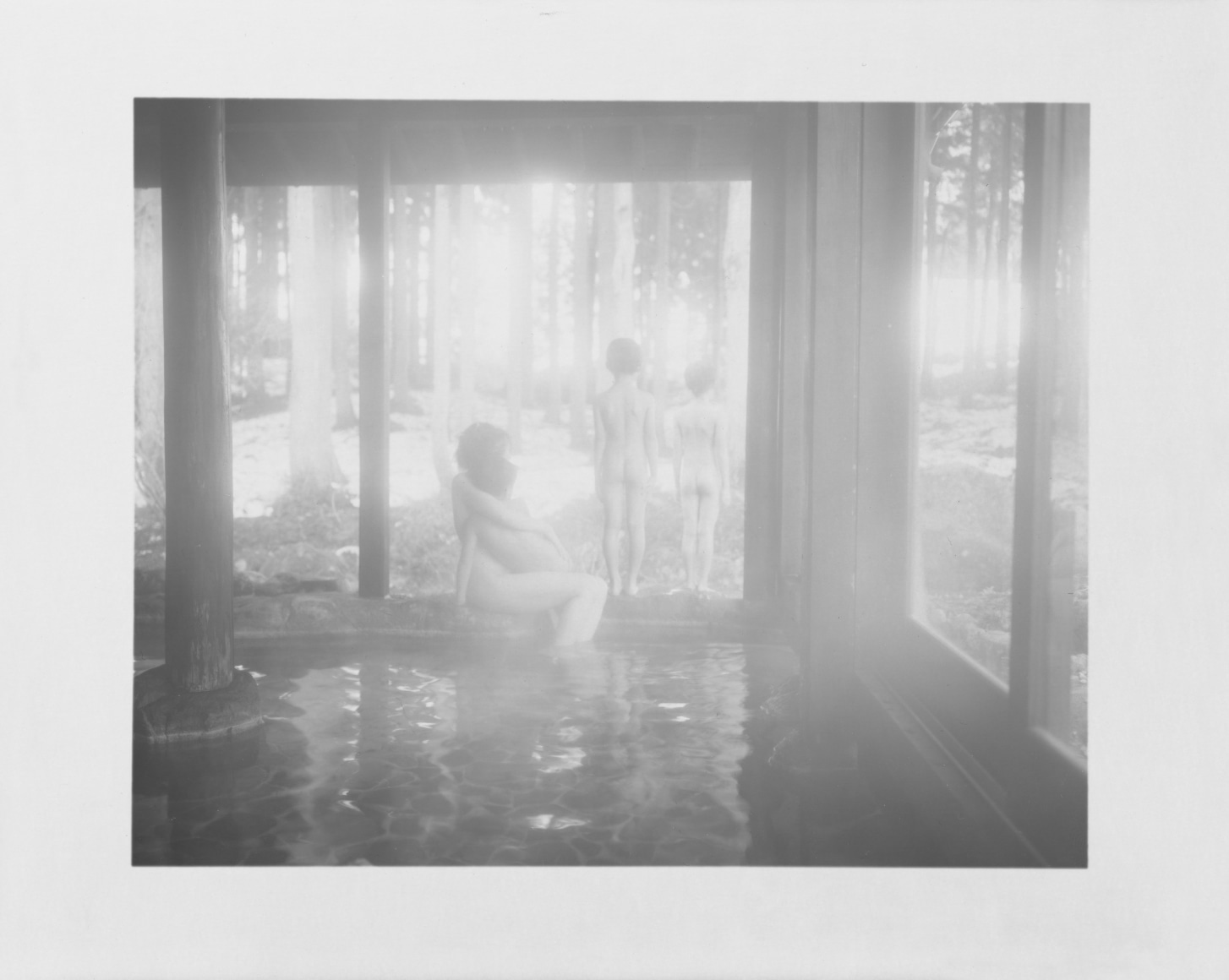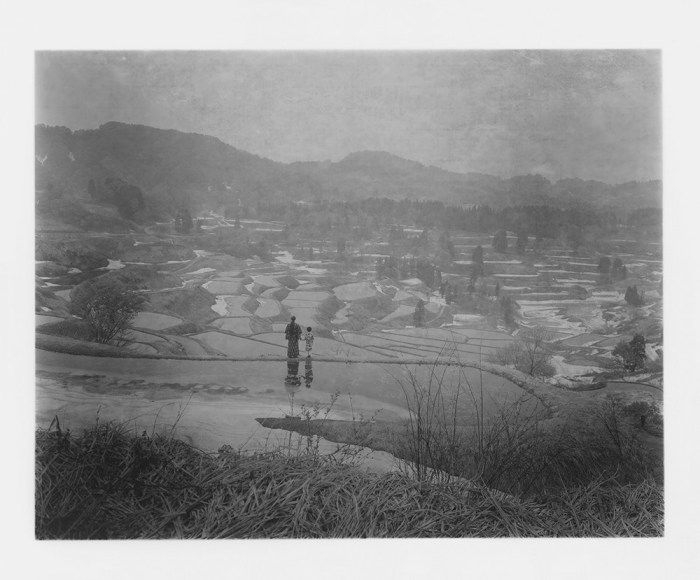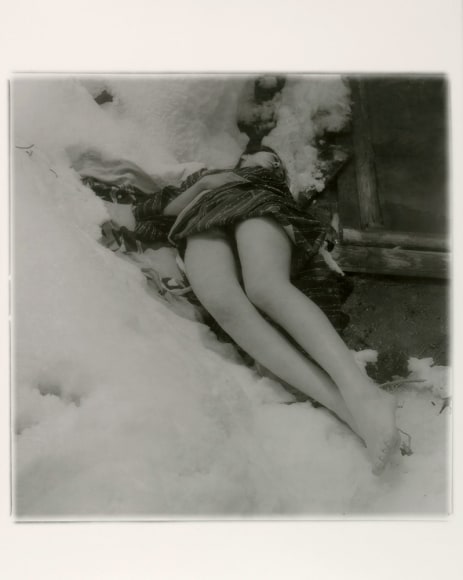Above all, it is the relationship between humans and nature that has always been RongRong & inri’s primary concern, even when they were living in Beijing. “Even when we travel to a new location,” they have said, “it is not only what we see with that registers. We also smell the air, feel the humidity and the temperature. This is what we attempt to convey, as well as a temporal dimension that situates the apparent subject-matter in a realm beyond time.” To accomplish this they use a variety of innovative techniques in the darkroom, including multiple exposures, layered effects achieved through the introduction of textured materials during the printing and a judicious use of hand tinting.
In some of the most haunting images, the artists are seen as disembodied or fragmentary forms in an ambiguous space that melds interior and exterior, the chiseled floor of the house where they were staying and landscape and underwater motifs. In two haunting images RongRong’s face emerges from a gnarled tree while the naked figure of inri seems to be sinking into the floor in another. The long scroll suspended from the ceiling develops this tendency on a very large scale.
Chambers Fine Art is pleased to announce the opening on June 2, 2016 of RongRong & inri: Tsumari Story. In April RongRong & inri were awarded the Outstanding Contribution to Photography Award in London as part of the 2016 Sony World Photography Awards exhibition. Before 2000 when RongRong was based in Beijing and inri in Tokyo, they both pursued independent careers but since 2000 they have worked together, producing a body of work that is notable for the sensitive way in which it reflects the development of their life as a couple and the growth of their family as well as work of a more experimental nature.
In addition to their flourishing career as a photographic duo, they have also played a prominent role in the development of awareness of photography in China, establishing the Three Shadows Photography Centre in Caochangdi, Beijing in 2007 and the annual Three Shadows Photography Award the following year. A second center opened in Xiamen in 2015.
There has always been a strong autobiographical element in RongRong and inri’s photography as it traces the development of their relationship, from the lyrical effusions of 2000–2001 such as the In Yulongxueshan, China Series and the In Bad Goisen Austria Series to the tender recording of the rapid growth of their family in the Caochangdi, Beijing Series, 2004–2009. The construction of Three Shadows Photography Centre designed by Ai Weiwei also provided subject matter for their photography.
In 2012 they were invited to participate in the Echigo-Tsumari Art Triennial in Niigata Prefecture, Japan. This rural area, famous for its long winters and its spectacular snow storms, became the setting for Tsumari Story, in which RongRong, inri and their three sons abandon the urban life-style they were accustomed to in Beijing and respond to the beauty of the changing seasons in Japan. Using a 200 year old house subtly modified by Kurakake Junichi as the setting for the interior scenes, RongRong and inri portray themselves wearing Japanese kimono and convey the intensity of their relationship in carefully staged encounters. The three boys respond with joy to their new environment, clearly reveling in the unfamiliar pleasures of the Japanese life-style, sleeping on the floor and bathing in the clear waters of onsen (Japanese hot springs). Venturing outdoors even in the most harshest conditions, the photographers can be seen struggling over snow-drifts and testing how much the human body can endure as their garments fall from their bodies.
2016年4月,荣荣&映里在伦敦被授予了2016年度索尼世界摄影奖的摄影杰出贡献奖。在2000 年之前,荣荣在北京,映里在东京,各自追求自己的艺术事业。但自从2000年他们成为了摄影夫妻组合,创作了一系列更为实验性的作品,同时也用一种微妙敏锐的方式记载了他们从夫妻两人世界到一个五口之家的生活历程。
2012 年,他们应邀参加了位于日本新潟县的越后妻有艺术三年展。这个以漫长的冬季和壮观的暴风雪而闻名的偏远地区为《妻有物语》系列提供了场景。作品反映了荣荣、映里和他们的三个儿子放弃了早已习惯的北京都市生活,面对日本一年四季的不同美景所产生的感受。以一栋有200 年历史的老宅为背景,荣荣和映里身着日本浴衣,以精心策划的各种场景突出他们强烈的感情 。
然而,一直以来人类与自然之间的关系才是荣荣&映里最为关注的主题,即便当初他们在北京生活时也是如此。他们说,“即使我们去到一个新的地方,不仅仅只是我们眼睛所见到的会给我们留下印象与感觉。我们也闻到空气的味道,感受到温度和湿度。这些也正是我们试图表达的,另外还有一个将主题置于时间之外的时空维度。”为了达到这个效果,他们在 暗房里不断创新,采用了包括多重曝光、在冲印中采用各种质地的材料以取得层叠效果、以及谨慎手工着色等创新技法。
在本系列一些最令人难以忘怀的画面中,两位艺术家的身体局部呈现在一些让人摸不着头脑的背景之中,有的将室内场景和室外场景巧妙地结合在了一起,有的在老宅凿刻过的地板上,有的是周边风景或水的波纹。从天花板悬挂下来的长幅画卷便以巨幅尺寸呈现出这一创作特点。

